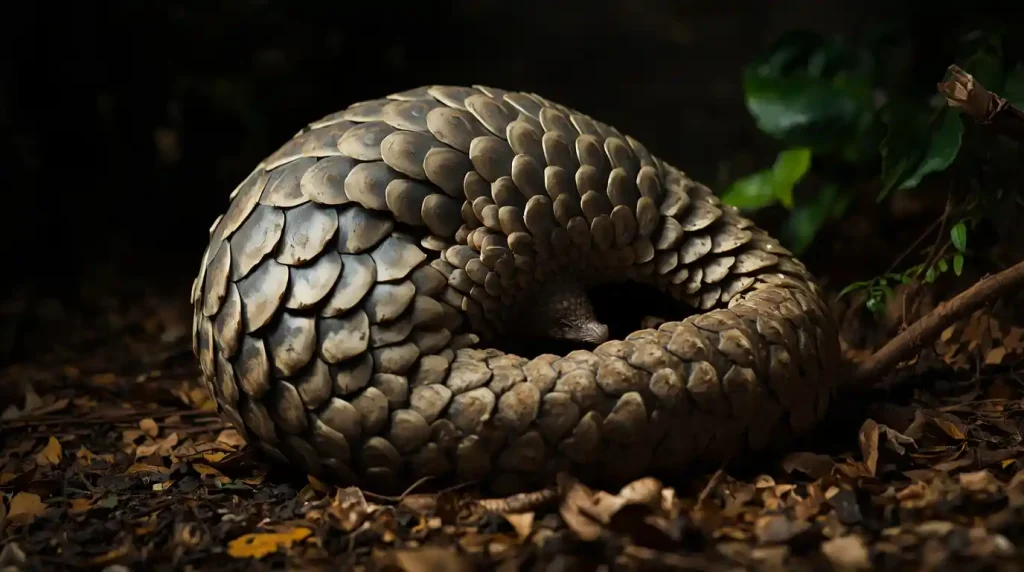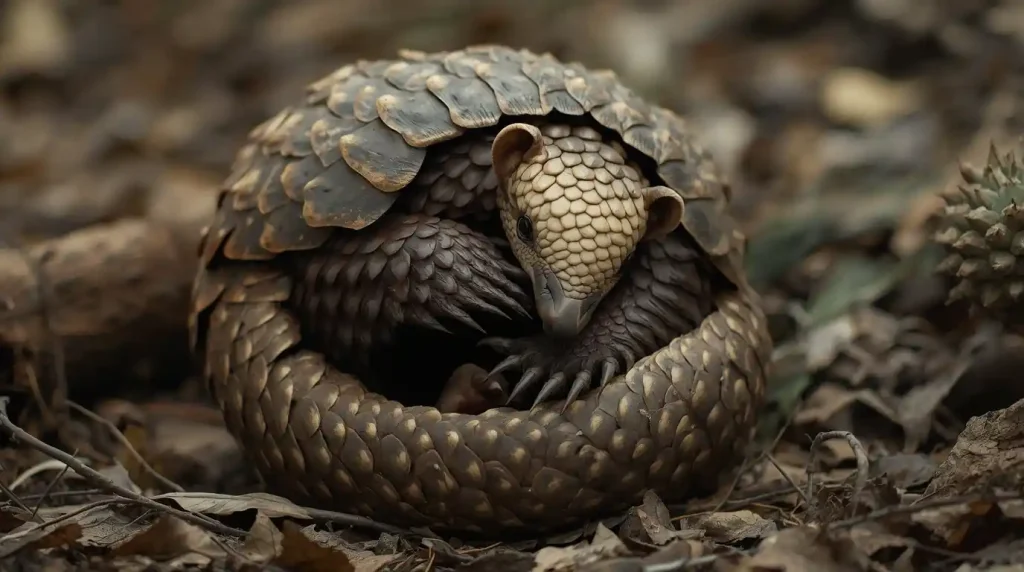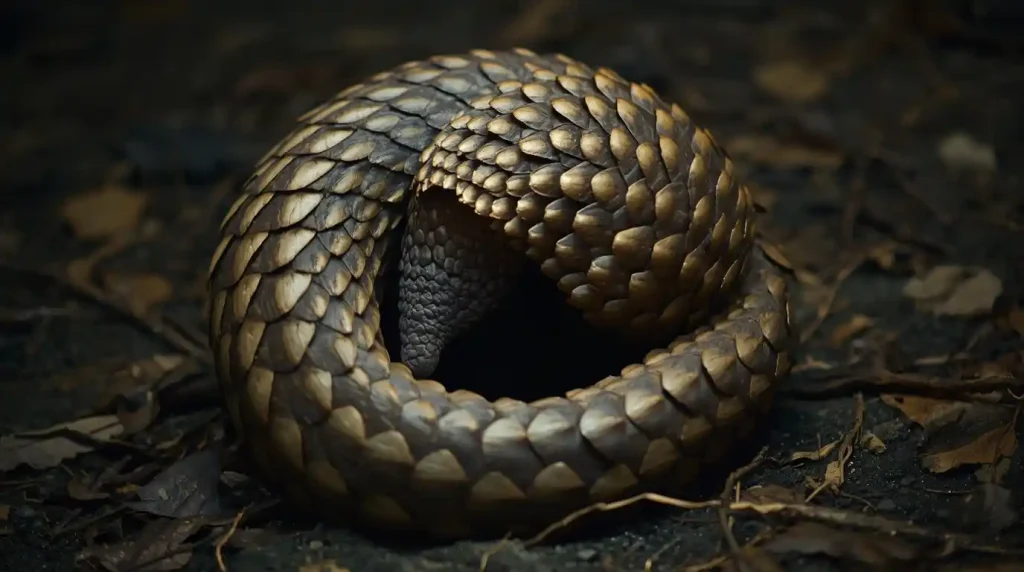A pangolin in its classic defensive curl. This instinct makes it tragically easy for poachers to collect.
In the silent, shadowy realms of forests and savannas across Africa and Asia, a quiet tragedy is unfolding. An ancient, scale-clad creature, often described as a walking artichoke, is being systematically erased from the wild. This is the story of the Pangolin’s plight. It is a narrative not of a natural decline, but of a relentless, human-driven onslaught that has earned this shy, nocturnal animal a grim title: the world’s most trafficked mammal.
While rhinos and elephants often dominate conservation headlines, the Pangolin’s plight remains a critically underreported crisis, happening largely out of sight and out of mind. But now, a powerful new weapon has entered the fight: the lens of a camera. This article explores the depths of the Pangolin’s plight and how a stunning photographic project, “Remembering Wildlife,” is aiming to change its fate.
1. What is a Pangolin? The Alien Mammal
To truly grasp the Pangolin’s plight, one must first understand what a pangolin is. These unique creatures are taxonomic marvels. They are the only mammals wholly covered in hard, keratinous scales, which they use as a suit of armor against natural predators. When threatened, their signature defense is to roll into an impenetrable ball, protecting their soft underbelly.
There are eight species of pangolin: four in Asia (the Indian, Philippine, Sunda, and Chinese pangolins) and four in Africa (the Giant Ground, Temminck’s Ground, White-bellied, and Black-bellied pangolins). They are insectivores, often called “scaly anteaters,” using their long, sticky tongues to devour ants and termites. A single pangolin can consume up to 70 million insects annually, making them a crucial natural pest controller and a vital part of a healthy ecosystem. Despite their reptilian appearance, they are mammals; mothers carry their young on their tails and nurse them. This very uniqueness, however, is at the core of the Pangolin’s plight. Their scales, which should be their greatest protection, have become their curse.
2. The Scale of the Crisis: Understanding the Trafficking
The statistics behind the Pangolin’s plight are nothing short of apocalyptic. According to the wildlife trade monitoring network TRAFFIC, nearly one million pangolins were trafficked between 2000 and 2019, though the true figure is likely far higher due to the clandestine nature of the trade. This scale of exploitation is unsustainable for a slow-breeding animal that typically gives birth to a single pup per year.
The illicit trade in pangolins is a sophisticated, international criminal enterprise. Poachers in Central Africa or Southeast Asia snare the animals and sell them up a chain that leads to major shipping ports. Pangolins are smuggled alive, frozen, or already butchered for their scales. Their scales are often shipped separately from the meat, making detection more difficult.
The sheer volume of seizures is staggering; in 2019, Malaysian authorities seized a record 30 tons of pangolin scales, representing up to 40,000 individual animals from a single bust. This relentless pressure has pushed all eight species towards extinction, with the Chinese and Sunda pangolins listed as “Critically Endangered” on the IUCN Red List. The Pangolin’s plight is a direct result of this industrial-scale wildlife crime.

Internal Resource: The Silent Extinction: 10 Lesser-Known Endangered Animals
3. Demand and Delusion: The Drivers of the Plight
What fuels this devastating trade? The Pangolin’s plight is driven by two powerful and persistent demands: one for its meat and the other for its scales.
- Pangolin Meat: In parts of China and Vietnam, pangolin meat is considered a luxury delicacy and a status symbol. It is often served at banquets to wealthy businesspeople and government officials as a display of wealth and influence. The meat can fetch hundreds of dollars per kilogram in illegal markets.
- Pangolin Scales: The primary driver of the modern Pangolin’s plight is the demand for scales. In Traditional Asian Medicine, despite having no proven medicinal properties, pangolin scales are falsely believed to cure a range of ailments, from arthritis and lactation difficulties to cancer. The scales are made of keratin, the same substance as human fingernails and hair, yet they are ruthlessly harvested, dried, and ground into powder for unproven remedies.
This demand is underpinned by cultural tradition, superstition, and a profound lack of public awareness about the catastrophic impact of the trade. Combating the Pangolin’s plight requires not only law enforcement but also a massive educational campaign to dismantle the myths fueling their consumption.
4. A Photo Book as a Beacon: The “Remembering Wildlife” Mission
In the face of such a grim reality, hope often comes from creative and passionate voices. This is where the “Remembering Wildlife” series comes in. Founded by photographer Margot Raggett, the project brings together the world’s best wildlife photographers to create stunning photo books dedicated to a single endangered species or group. The latest volume focuses entirely on the pangolin.
The mission is simple yet powerful: to create the most beautiful book ever seen on a species, using its beauty to raise awareness and funds. All profits from the sale of the book are donated to carefully vetted conservation organizations working on the ground to protect the featured animal. For the Pangolin’s plight, this means direct financial support for anti-poaching patrols, wildlife rehabilitation centers, and community education programs in Africa and Asia.
By showcasing the pangolin’s unique beauty and gentle nature through breathtaking imagery, the book aims to forge an emotional connection with the public—a connection that statistics and news reports often fail to achieve. It is a direct attempt to turn the tide of the Pangolin’s plight through art and empathy.

5. Conservation in Action: Heroes Fighting the Good Fight
While the “Remembering Wildlife” book raises crucial funds and awareness, the real frontline of the battle against the Pangolin’s plight is fought by dedicated conservationists and organizations. Groups like the IUCN SSC Pangolin Specialist Group, TRAFFIC, and the Wildlife Justice Commission are working tirelessly on multiple fronts.
Their work includes:
- Intelligence-Led Law Enforcement: Working with governments to disrupt trafficking networks and improve prosecution rates.
- Community Engagement: Working with local communities living near pangolin habitats to provide alternative livelihoods and turn them into protectors rather than poachers.
- Pangolin Rehabilitation: Running specialized facilities, like the Save Vietnam’s Wildlife rescue center, that nurse trafficked pangolins back to health and reintroduce them into safe, protected areas.
- Demand Reduction: Running campaigns in consumer countries like Vietnam and China to educate the public about the biological reality of pangolins and the devastating consequences of the trade.
These efforts are dangerous, underfunded, and emotionally taxing, but they are the only thing standing between pangolins and extinction. The Pangolin’s plight is being challenged by their unwavering dedication.
Internal Resource: Interview with a Wildlife Vet: Saving Pangolins from the Trade
6. The Ripple Effect: Why Losing Pangolins Matters for Everyone
Some may ask, “Why should I care about this obscure animal?” The answer is that the Pangolin’s plight is not an isolated issue; it is a symptom of a broken relationship with our natural world, and its consequences ripple outward.
Ecologically, pangolins are known as an “umbrella species.” Protecting them and their vast forest habitats automatically protects countless other species that share that ecosystem, from insects and birds to large mammals. Their role as pest controllers is also vital for soil health and agriculture; by preying on termites, they prevent these insects from decapitating crops and damaging trees.
Furthermore, the illegal wildlife trade is a major source of revenue for international criminal syndicates, often linked to other crimes like corruption, money laundering, and arms trafficking. Finally, as the COVID-19 pandemic highlighted, the unregulated wildlife trade poses a significant risk for zoonotic disease spillover, threatening global public health. Addressing the Pangolin’s plight is, therefore, about preserving ecosystems, combating international crime, and safeguarding human health.

7. How You Can Help: 5 Ways to Make a Difference
The Pangolin’s plight can feel overwhelming, but no action is too small. Here are five concrete ways you can contribute to their survival:
- Support Legitimate Conservation Efforts: Donate to organizations on the front lines. Purchasing the “Remembering Pangolins” photo book is a fantastic way to do this, as 100% of the profits go to vetted projects.
- Educate Yourself and Others: Share articles, photos, and documentaries about pangolins. The more people know about the Pangolin’s plight, the less acceptable their consumption becomes.
- Be a Responsible Tourist: Never purchase souvenirs made from wildlife products, especially scales or carvings. Report any suspected illegal wildlife trade you encounter.
- Use Your Voice on Social Media: Follow conservation groups and share their content. Use hashtags like #WorldPangolinDay (the third Saturday in February) and #PangolinsPlight to amplify the message.
- Write to Your Representatives: Urge your government to prioritize wildlife crime, provide funding for international conservation, and enforce laws like the U.S. END Wildlife Trafficking Act.
8. Conclusion: A Future for the Scaled Ghost
The Pangolin’s plight is one of the most urgent and tragic conservation stories of our time. It is a story of unique beauty meeting brutal greed, of ancient instincts failing against modern threats. But it is not yet a story with a foregone conclusion. The dedicated work of conservationists, the powerful imagery of photographers, and the growing voice of a concerned global public are writing a new, more hopeful chapter.
The fate of the pangolin hangs in the balance. Will we be the generation that stood by as this scaled ghost vanished forever, or will we be the one that ensured its survival? The choice is ours. By supporting the efforts to protect them, we don’t just save a single species; we uphold the integrity of our natural world and our responsibility within it. The time to act on the Pangolin’s plight is now.

Table of Contents
Reference Website:
https://edition.cnn.com/world/pangolin-remembering-wildlife-photos-conservation-c2e-spc
Our Related News Website:
Sports: Sport Flash
World News: The News Grid
Environment News: Eco Alert
Business News: Biz Trend Now
Dailt News: Unbiased Daily
Realm News: Real Time Realm
Retrun to our Homepage



